


The Tarot of Ideals



The Suits
When reading the minor suit cards, it may be best to look first at the suit, then the number or character (contrary to how we refer to them, “nine of cups” and so forth). The suits date back to the Mamluk deck of playing cards from fourteenth century Egypt, with possible roots in ancient Persia. Their original meanings may have had to do with four social classes or occupations. The associations that seem most persistent in European culture are those with the four classical elements: earth, air, water, and fire for coins, swords, cups, and rods respectively.
The suits and and their associations are often described as discrete categories that suggest four pieces of a pie. But the opponent pairs, earth and air, and water and fire, represent polarities that suggest two Cartesian axes. Air and earth suggest the above and below, while water and fire suggest the inner and outer.
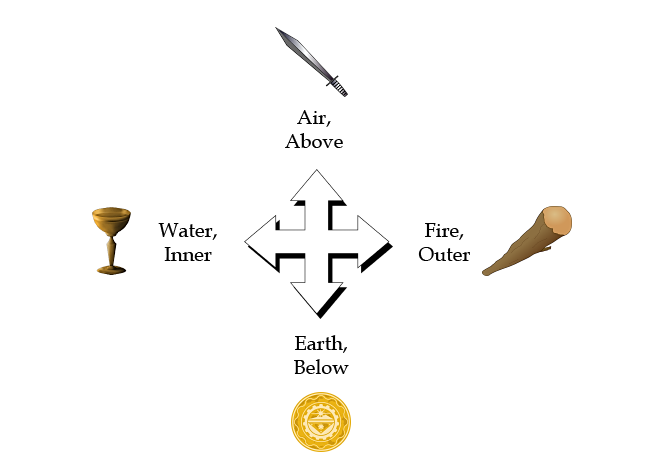
From another perspective, water and fire suggest the receptive and creative qualities of yin and yang. Air and earth would then represent heaven and earth, the world if ideas vs. the material world. (Is there a third axis? Maybe good and evil.) A cosmologic framework like this helps to define the suits and identify what characteristics are associated with them.
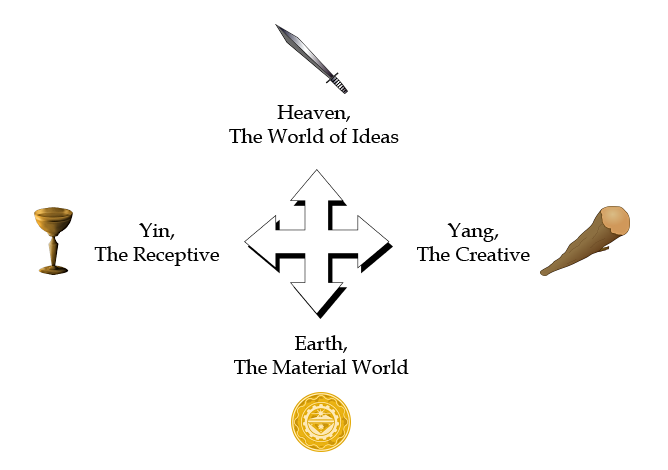
Heaven and earth, the above and the below, represent the intangible aspect of man vs. the physical, the ghost vs. the machine. Yin and yang, by contrast, represent the inner, emotional aspect of man vs. the outer, visible world of actions. Note that the axes remain separate; man’s mental and physical aspects may each have active and receptive qualities; and one’s emotions, for example, depend both on one’s mental and physical states.
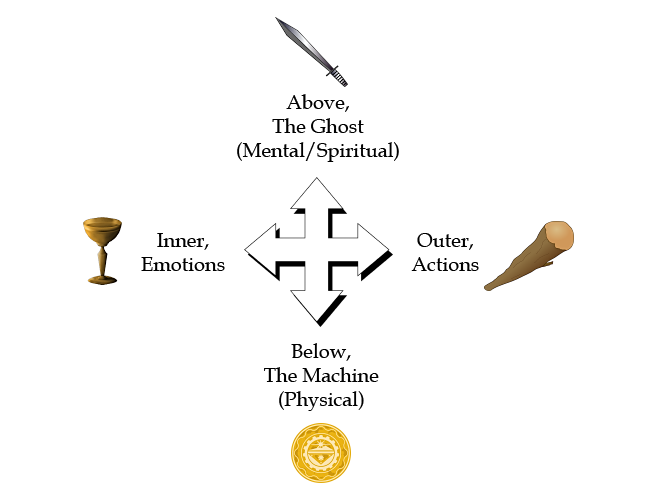
The suits on adjacent axes have been noted to have certain basic relationships, notably, cups as “right brain” vs. swords as “left brain”. Extending the nervous system analogy, coins and rods may then be taken to represent sensory and motor phenomena, respectively. These domains represent the processes of intuition, reason, observation, and action. From a perpendicular perspective, if cups represent emotions and coins represent sensory perceptions, then swords represent the intellect, and rods represent the will. (Side note—flipping the axes like this suggests an underlying tetrahedral symmetry.)
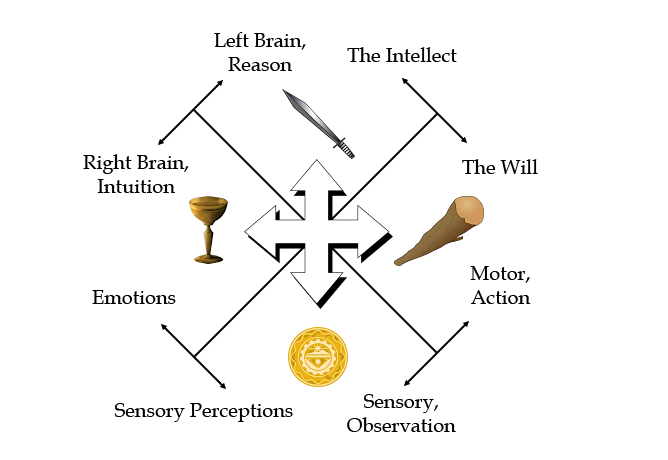
Applied to the world in general, cups represent the secret or hidden aspects of a process, and rods the public or visible aspects. If coins represent the simple material aspect of the world, then swords represent the organizational aspect, emergent or holistic phenomena that go beyond the sum of the parts.
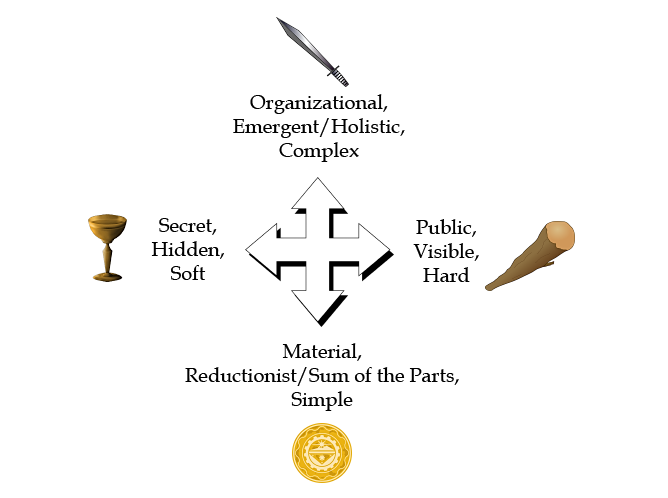
Paul Huson traces the suit images back to traditional represenations of the cardinal virtues: the mirror (or coin) of prudence, the sword of justice, the cup of temperance, and the rod of fortitude. Temperance does in fact suggest a holding back, while fortitude suggests action. According to the relationships above, justice would be interpreted as an intellectual or spiritual quality, while prudence applies to practical, worldly affairs. (As opposed to prudence being defined as a kind of wisdom, or a sword quality, and justice being seen as equal treatment in society, suggesting coins.)
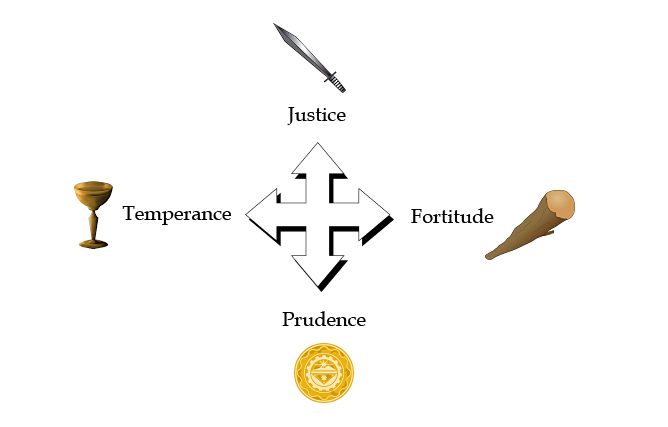
There is no universal agreement on the sum total of the meanings of each of the suits; the above is one way of looking at them. A major uncertainty seems to be where to place spirituality; it is sometimes considered to be part of man’s inner makeup, and associated with cups; however, it has also been associated with the creativity of rods. Note that in the above configuration, as already mentioned, each axis is independent and may apply to any aspect of the perpendicular axis. Spirituality is part of man’s non-physical makeup, clearly the “ghost” and not the ”machine,” and is represented by swords, as is the intellect. One’s spirituality thus has a basis in the beliefs and values of swords, but it may then go on to be manifested by the emotions and inner experience of cups, as well as the active behavior of rods such as ritual practice and defense of the right.
Below are the items above, plus a few more, in table form. The lists are a little redundant to preserve the horizontal relationships. This is, of course, just a start, a basic outline to organize and stimulate your own ideas and how they relate to your situation.
Cups |
Rods |
Swords |
Coins |
| Water | Fire | Air | Earth |
| Inner | Outer | Above | Below |
| Yin | Yang | Heaven | Earth |
| The receptive | The creative | The world of ideas | The material world |
| Emotions | Actions | The mental/spiritual | The physical |
| Right brain | Motor | Left brain | Sensory |
| Intuition | Action | Reason | Observation |
| Emotions | The will | The intellect | Sensory perceptions |
| Secret | Public | Organizational | Material |
| Hidden | Visible | Emergent/holistic | Reductionist/sum of the parts |
| Soft | Hard | Complex | Simple |
| Temperance | Fortitude | Justice | Prudence |
| Mysterious | Manifest | Sacred | Profane |
| Change | Realization | Plans | Permanence |
| Influence | Control | Mastery | Support |
| Loyalty | Action | Authority | Obedience |
| Family, friends | Coworkers | Superiors | Subordinates |
| Introverted | Extroverted | Idealistic/Analytic | Pragmatic/Realistic |
For the purpose of interpreting the relationships between cards, the opponent pairs, cups and rods (water and fire) and coins and swords (earth and air), are sometimes considered to be in conflict. The adjacent pairs, cups and coins (cold) and swords and rods (hot) are considered to be mutually supportive. Cups and swords, and coins and rods, are neutral. (The latter are classically associated with the properties wet and dry. I cannot help but think that there must be some property associated with even the opponent pairs, a name for those axes; the best I can come up with is light and dark.)
Some also associate each of the trump cards with one of the “elemental dignities” of the suits. I believe that there are some natural associations, such as with the Emperor and Empress, but I do not consider them to be absolute rules, and some cards are more ambiguous.